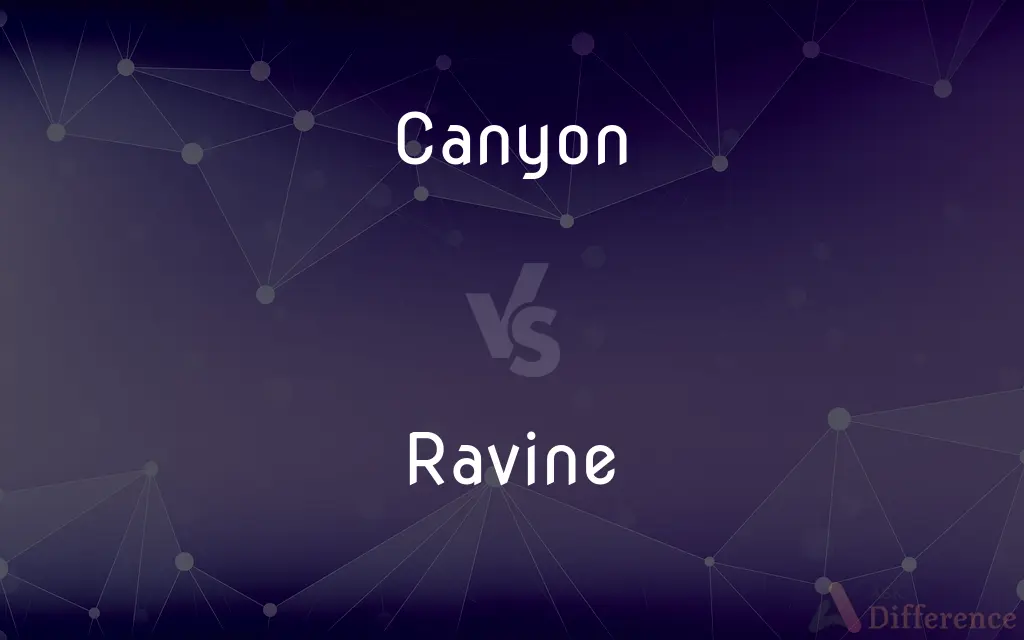Canyon vs. Ravine — What's the Difference?
By Tayyaba Rehman & Urooj Arif — Updated on March 24, 2024
Canyons are large, deep geological formations with steep sides, carved by river erosion over millions of years, while ravines are smaller, narrow valleys formed by water or geological activity.

Difference Between Canyon and Ravine
Table of Contents
ADVERTISEMENT
Key Differences
Canyons are characterized by their grand scale and steep sides, often resulting from the erosive action of rivers over millions of years. These majestic formations can be found in various parts of the world, showcasing the powerful forces of nature. Ravines, on the other hand, are smaller, narrower valleys more commonly formed by streams or minor geological shifts, and they may not exhibit the same dramatic scale as canyons.
While canyons, such as the Grand Canyon, are renowned for their vast and scenic landscapes, attracting tourists and nature enthusiasts, ravines are often less known and may be hidden within landscapes, serving as natural drainage courses or secluded habitats for wildlife. Whereas ravines offer more intimate encounters with nature, canyons provide expansive views and a sense of the earth's immense geological history.
Canyons often serve as significant natural landmarks and are important for scientific research, offering insights into geological processes, climate change, and the history of the Earth. Ravines, whereas, while less studied, can also be important for local ecosystems, offering habitats and microclimates that support diverse plant and animal life.
The formation of a canyon is a testament to the long-term effects of river erosion, where water powerfully carves away rock over geological time scales. Ravines, on the other hand, can form more rapidly in geological terms, often as a result of water runoff, erosion, and minor geological activities such as landslides.
In terms of accessibility, canyons, because of their size and the interest they generate, often have established paths, visitor centers, and viewing areas. Ravines are usually more wild and less accessible, providing a more rugged and unspoiled nature experience for those who seek them out.
ADVERTISEMENT
Comparison Chart
Size
Large and deep
Smaller and narrower
Formation
Primarily by river erosion over millions of years
By water or minor geological activity
Landscape Impact
Majestic and scenic, often a tourist attraction
More intimate, often hidden within landscapes
Geological Importance
Offers insights into Earth's history and geological processes
Important for local ecosystems, less studied
Accessibility
Often have established paths and facilities
More rugged and less accessible
Compare with Definitions
Canyon
A deep, narrow valley with steep sides.
The Colorado River carved out the Grand Canyon over millions of years.
Ravine
A small, narrow valley.
The ravine was filled with lush vegetation, hidden from the surrounding landscape.
Canyon
Tourist attraction.
Many canyons are protected as national parks and draw visitors from around the world.
Ravine
Less known and visited.
The ravine remained a local secret, known only to nearby residents.
Canyon
Geological research site.
Scientists study canyons to understand Earth's geological history.
Ravine
Subject to geological activity.
A recent landslide altered the course of the stream running through the ravine.
Canyon
Subject to erosion.
The process of erosion continues to shape and deepen canyons over time.
Ravine
Formed by water erosion.
Spring rains carved deeper into the ravine, shaping its narrow walls.
Canyon
Feature in desert and mountain regions.
Canyons are common in arid environments where rivers have cut through the landscape.
Ravine
Habitat for wildlife.
Ravines often provide secluded habitats for a variety of animals and plants.
Canyon
A canyon (from Spanish: cañón; archaic British English spelling: cañon) or gorge is a deep cleft between escarpments or cliffs resulting from weathering and the erosive activity of a river over geologic time scales. Rivers have a natural tendency to cut through underlying surfaces, eventually wearing away rock layers as sediments are removed downstream.
Ravine
A ravine is a landform that is narrower than a canyon and is often the product of streambank erosion. Ravines are typically classified as larger in scale than gullies, although smaller than valleys.
Canyon
A deep gorge, typically one with a river flowing through it, as found in North America
The Grand Canyon
Ravine
A deep, narrow gorge with steep sides.
Canyon
A narrow chasm with steep cliff walls, cut into the earth by running water; a gorge.
Ravine
A deep narrow valley or gorge in the earth's surface worn by running water.
Canyon
A valley, especially a long, narrow, steep valley, cut in rock by a river.
Ravine
A deep narrow valley or gorge in the earth's surface worn by running water.
Canyon
The English form of the Spanish word Cañon.
Ravine
(archaic) raven
Canyon
A ravine formed by a river in an area with little rainfall
Ravine
A torrent of water.
Ravine
A deep and narrow hollow, usually worn by a stream or torrent of water; a gorge; a mountain cleft.
Ravine
A deep narrow steep-sided valley (especially one formed by running water)
Common Curiosities
Can a ravine become a canyon?
While both are formed by erosion, the scale and processes differ significantly, making such a transformation unlikely.
How does water shape ravines?
Water runoff and erosion play key roles in shaping ravines, carving out narrow valleys.
What defines a canyon?
A canyon is a large, deep valley with steep sides, primarily formed by the erosion from a river over millions of years.
How do ravines differ from canyons?
Ravines are smaller, narrower valleys formed by water or minor geological activities, lacking the grand scale of canyons.
Why are ravines less accessible than canyons?
Ravines are often more rugged and wild, lacking the paths and facilities found in more tourist-friendly canyons.
Why are canyons important for scientific research?
Canyons offer insights into geological processes, Earth's history, and climate change.
Are ravines important for ecosystems?
Yes, ravines can provide critical habitats and microclimates for diverse plant and animal life.
What is the largest canyon in the world?
The Grand Canyon is one of the largest and most famous, but there are deeper and longer canyons, such as the Yarlung Tsangpo Grand Canyon in Tibet.
How are canyons formed?
Most canyons are formed by the process of river erosion over a long period.
What role do canyons play in tourism?
Canyons often serve as major tourist attractions, offering stunning landscapes for sightseeing, hiking, and photography.
What makes a canyon iconic?
Size, scenic beauty, and geological significance contribute to a canyon's iconic status.
Can humans create ravines or canyons?
Human activities can accelerate erosion, potentially leading to the formation of ravine-like structures, but creating canyons like those formed naturally over millions of years is beyond current human capability.
How do animals and plants adapt to life in ravines?
They often adapt to more shaded, moist, and secluded conditions compared to the surrounding landscape.
Are all canyons dry and arid?
No, canyons can be found in a variety of climates, including lush and water-rich environments.
What's the difference between a gorge and a canyon?
The terms are often used interchangeably, but some distinguish a gorge as narrower and more rugged than a canyon.
Share Your Discovery

Previous Comparison
Muscat vs. Muscadet
Next Comparison
Agraphia vs. DysgraphiaAuthor Spotlight
Written by
Tayyaba RehmanTayyaba Rehman is a distinguished writer, currently serving as a primary contributor to askdifference.com. As a researcher in semantics and etymology, Tayyaba's passion for the complexity of languages and their distinctions has found a perfect home on the platform. Tayyaba delves into the intricacies of language, distinguishing between commonly confused words and phrases, thereby providing clarity for readers worldwide.
Co-written by
Urooj ArifUrooj is a skilled content writer at Ask Difference, known for her exceptional ability to simplify complex topics into engaging and informative content. With a passion for research and a flair for clear, concise writing, she consistently delivers articles that resonate with our diverse audience.
















































